Brazilian Beauty: The Threatened Atlantic Forest

Forest interior

It's the most threatened rainforest in Brazil, a global biodiversity hotspot, and contains around one in 12 of all species on the planet. We must be talking about the Amazon, right? Wrong. It's the Atlantic Forest, which used to run in a continuous strip along the 2,000 miles of Brazil's eastern seaboard, up the steep coastal mountain slopes and, in places, far into the interior, reaching parts of Paraguay and northern Argentina.
This stunning image, with morning sunlight streaming through the canopy, gives a sense of the forest's magic and exuberance. In one part of the ecosystem, some 450 species of trees were once found in a single hectare (2.5 acres). Whereas the Amazon has lost around 18 percent of its original extent, barely seven percent of the Atlantic Forest remains, at least in remnants large enough to be considered viable (100 hectares or more).
This state park in the Upper Ribeira Valley, in one of the largest intact patches of the forest, is just half a day's drive from the megacity of São Paulo and that helps explain why there is so little left. The Amazon is thousands of miles from where most Brazilians live, but the Atlantic Forest has been right in the path of agricultural and urban development for 500 years, and now 130 million people live within its boundaries. Finally, its treasures are starting to be valued.
Giant bromelia
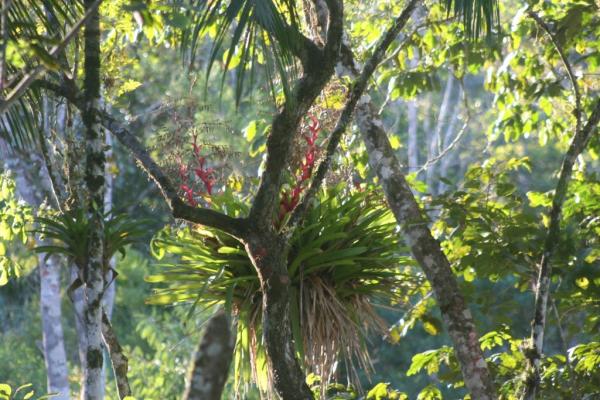
People talk about tropical forests as if they are "just" a collection of trees. It's kind of like saying a great city is just a bunch of buildings. Walk amongst the skyscrapers of the Atlantic Forest, and you see that each tree is a vibrant community in itself, covered from top to bottom with hundreds of other plants piggy-backing on its structure to grab a bit of precious sunlight. These are the epiphytes plants that grow on another but do not harm them by robbing their nutrients, unlike parasites. This massive Vriesia bromeliad is an impressive example. Believe it or not, it is from the same family as the pineapple.
Measuring several feet across, the bromeliad nestles in the crook between the trunk and a large bough, attached by ultra-strong tendrils, and lives entirely independently of the tree. It drops aerial roots down to the ground, using the tree trunk as a kind of service shaft, to collect nutrients and water. It also creates its own water supply through the shape of its overlapping leaves, which funnel rainwater into the plant's base. This provides a kind of high-rise pool for the inhabitants of the busy condominium: Birds line up to take a refreshing dip in the hot tropical sun, and tree frogs use it as a nursery for their eggs and tadpoles. In the mornings and evenings, the forest sings with the sweet, high-pitched chirping of tree frogs from the bromeliads overhead.
To cap off its multiple roles in the ecosystem, the bromeliad's bright red and purple flowers are a magnet for hummingbirds as they flit with impossible maneuvers from flower to flower, spreading pollen.
Dead-leaf Mantis
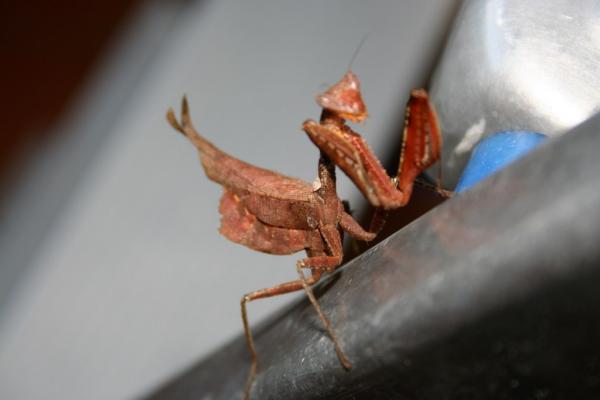
Like any forest, this one has its scary side. The variety of insects, spiders and bugs of every description is staggering, and some have evolved the most extraordinary tricks to stay hidden. Unless, of course, like this Dead-leaf Mantis, you emerge from the undergrowth and take a stroll up an aluminum ladder round the back of the house. As I approached close to take this photo, the mantis began to sway gently from side to side, mimicking the movement of a leaf in the wind. Imagine how effective this camouflage of color, shape and movement must be in the leaf litter of the forest floor and how deadly for the bizarre creature's prey as it passes by unsuspecting.
Ant ball
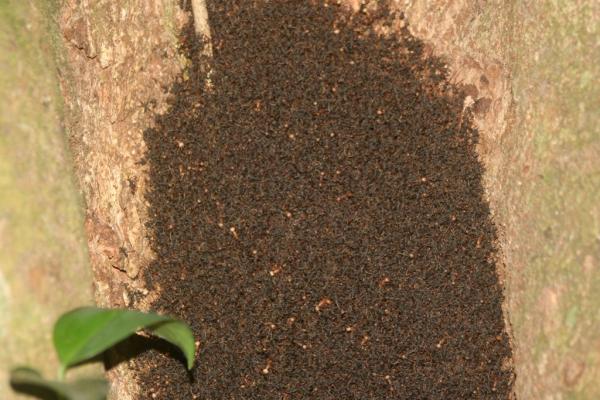
Even more scary, but truly fascinating, was this nest of army ants I came across in the hollow of a tree by a forest trail. Look closely at the brown patch and you will see it is a seething mass of ants the dark brown bits are the smaller workers and the white dots the heads of the larger soldiers. I gingerly poked a stick into the mass and found it was the best part of a foot in depth if I stuck my hand in I wouldn't vouch for much flesh being left on it when I pulled it out again.
These are fierce, biting ants and the first reaction to them may be disgust and fear. But they play a fundamental role in this ecosystem, as I have discovered in my time observing this forest.
After building up their numbers in nests like this one, the army ants march out in wide phalanxes, like rivers rushing across the forest floor, and invade a patch of undergrowth where they swarm in a seemingly chaotic frenzy, covering the leaf litter like a carpet and crawling along every low twig and branch. It is easy to stumble into one of these swarms unwittingly fortunately there is a kind of security alert, once you listen out for it. A whole variety of birds spend most of their time following the swarms, not to eat the ants, but to feast on the displaced creepy crawlies fleeing up trees or anywhere to escape the invasion. Amongst the "ant-followers" one or two bird species have especially loud calls that alert the rest, and bumbling humans, to the presence of the swarms. These antbirds, antwrens, ant-tanagers, woodcreepers, etc., make up a significant part of the nearly 1,000 bird species in the Atlantic Forest, so ants really do play a vital role in the diversity of this place.
Red-breasted Toucan eating juçara

Here's another example of the interrelationship between forest species. The fruit of the sugar palm, or juçara, comes out in the Southern Hemisphere autumn-winter, when other fruit is scarce, and is enjoyed by no fewer than 47 different bird species. This Red-breasted Toucan shows amazing dexterity with its huge beak, deftly picking off a single fruit, tossing it in the air and swallowing it whole. The toucan later regurgitates the seed from the canopy. It drops to the forest floor and germinates, usually some distance from the parent plant this dispersal is vital to ensure the genetic diversity of the palm tree.
The juçara palm has another attraction which has caused huge damage to this "keystone" species and the food web it supports. The bulbous growing-point at the top of the trunk, where the palm fronds are formed (to the right of the toucan in this photo), contains a succulent tissue that is a favoured delicacy in just about every salad bar and pizza restaurant in Brazil. It is, unfortunately for the tree, absolutely delicious. To get one jar of the heart-of-palm, you have to kill a whole tree that may have taken seven or eight years to grow. Gangs of "palmiteiros" regularly invade forests to chop down every palm of the right age, leaving the trunk and fronds strewn on the forest floor and just taking the valuable hearts. Because the heart is edible before the tree first bears fruit, in many areas virtually all palms are taken out before maturity and the cycle of fruit-bird-seed dispersal is broken.
Fortunately, awareness of this devastation is increasing. Smart consumers can look for labels showing the palm hearts have been taken from sustainable juçara plantations, or from different species with multiple stems that will re-grow after harvest. Also, a local project in the Ribeira Valley, São Paulo state, is promoting the sustainable marketing of the juçara fruit, a close cousin of the Amazonian açai which is famed the world over as a high-vitamin, high-antioxidant health food. For some reason its Atlantic Forest relative has never grabbed that niche, and valuing the fruit will provide incentives for people to allow this beautiful tree to live to maturity, and to continue providing winter nourishment for toucans and so many other species.
Green-headed Tanager

The colors of Atlantic Forest birdlife leave even the most blasé observer breathless. Whoever named this species the Green-headed Tanager must have been overworked at the time not only is the head more blue than green, but it is a wholly inadequate description of a bird that seems to have been designed by an artist trying out every color in his palette. The Portuguese common name for the species, Saíra-sete-cores, or seven-colored tanager, is more appropriate, though confusingly that name in English is used for another, much rarer species from the Northeast Atlantic Forest.
The Green-headed Tanager is among some 200 bird species endemic to the Atlantic Forest in other words, they are found in no other ecosystem on Earth. While this bird has quite a wide distribution along the coastal forests, many have much more restricted ranges. The diversity of the birdlife is accentuated by the great variation in latitude (from near the Equator to beyond the Tropic of Capricorn) and altitude (from sea level to more than 8,000 feet, or 2,440 meters) that the forest covers. So for example, there are some bird species you never see more than about 500 feet (150 m) above sea level, and others that always stay in the coastal mountains and never drop down to the lowlands. This specialization makes many birds highly vulnerable to the changes people have made to the Atlantic Forest, and some 100 species are currently threatened with extinction.
Golden Lion-Tamarin
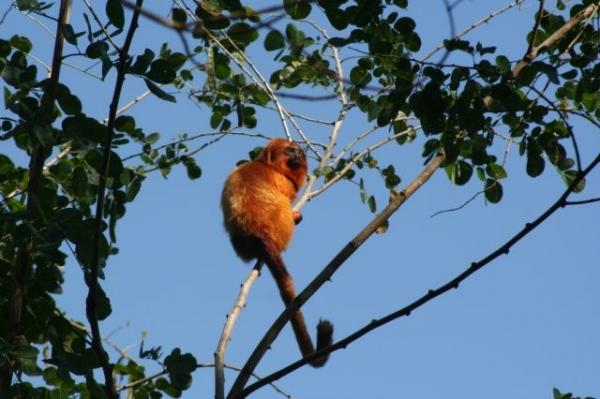
No animal species is more emblematic of the struggle to save the biodiversity of the Atlantic Forest than the Golden Lion Tamarin . This tiny monkey, weighing barely a pound, has a strikingly human-like face and a rich, golden coat and mane that explains its name. Once common in the coastal forests in the state of Rio de Janeiro, intensive destruction and fragmentation of its habitat drove the tamarin perilously close to extinction in the 1960s, clinging on to survival in just a couple of small forest patches.
Since the 1980s, a strong conservation effort to rescue this species has started to have an impact. The Golden Lion Tamarin Association (http://www.micoleao.org.br/) has been working with local farmers to help protect and connect their remaining territory, and re-introducing captive-bred tamarins to help boost the wild populations. Numbers are hard to verify, but estimates are that the population has grown from somewhere around 500 in the early 1990s to between 1,000 and 1,500 now. Still well short of the 2,000 thought to be needed to make the species viable in the long term, but enough to justify "downgrading" the Golden Lion Tamarin from Critically Endangered to Endangered on the Red List of Threatened Species.
I had the great privilege of being taken to see some of them at a location where food is left out so they can be studied. What the photos don't capture is just how tiny and vulnerable (and let's face it, darned cute) they really are.
Get the world’s most fascinating discoveries delivered straight to your inbox.
Sloth sleeping in Embauba
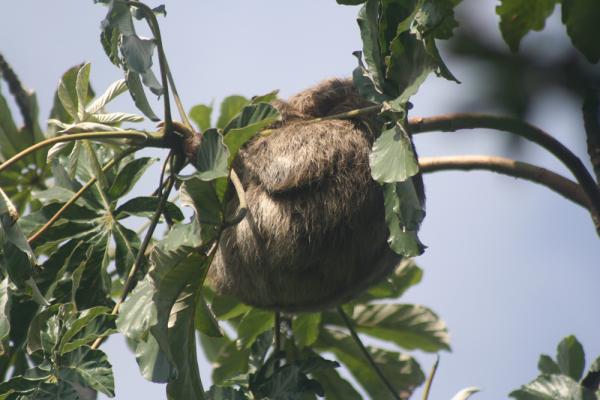
Here is another of those associations you learn to recognize as you make sense of the complex web of life in the Atlantic Forest. The Cecropia, or Embaúba, is a spindly tree with umbrella-shaped leaf clusters that shoots up quickly in a cleared area (in nature, when a big tree falls) to grab the light and act as the "pioneer" of a regenerating forest. Look up near the top of these trees and you may see what looks at first like an arboreal termite's nest, but turns out to be a peacefully sleeping sloth. These amazing mammals are strongly linked to the Cecropia as they love eating the leaves, although the link is not as exclusive as some references suggest I have seen them in other trees as well.
I find it very unfair that the sloth is named after one of the seven deadly sins. The Portuguese name, Bicho-preguiça, also means lazy or slothful beast. I loved the caption of a recent prize-winning photo of a sloth in a competition run by the Atlantic Forest conservation organization (www.sosmatatlantica.org.br), "Calm, but not slothful." Sure, they don't do anything in a hurry, but it is mesmerizing to watch their smooth, almost balletic movements through the branches as they hang upside down with the help of their strong claws. They do occasionally drop to the ground when the next tasty tree is out of reach, and I was touched once to see a truck driver stop to help a stranded sloth across a busy highway!
Back to the Cecropia and ants. This genus of tree and a genus of biting ants called Azteca show, throughout the American tropics, a striking example of "mutualism." The tree has evolved special nectar producing tissues inside the hollow trunk to keep the ants fed throughout their life cycle, and in return the ants act as security guards to keep other insects from attacking the tree. I love knocking on the trees and watching visitors' amazement as the ants come swarming out of natural gashes in the trunk to see who the intruder is.
Restinga and mountains, Jureia
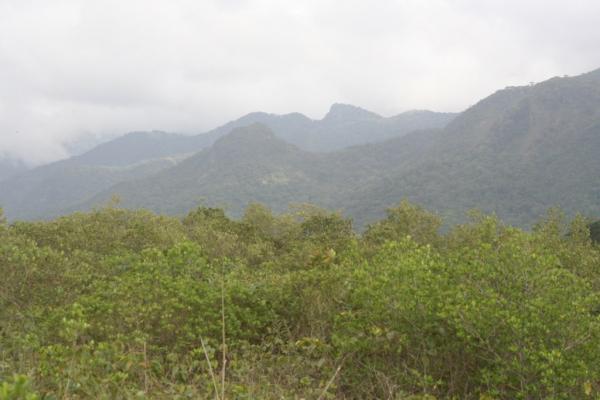
As mentioned, one of the features of the Atlantic Forest that gives it such diversity is the great range of altitudes that leads to different evolutionary adaptations from the mangroves of the tidal zone to the low, twisted trees of the nutrient-starved restinga, or white-sand forests, by the beach, through the rich lowland and slope forests to the rocky meadows of the high mountains. One of the few places where this "altitudinal gradient" has been left pretty much undisturbed from the tideline to the peaks is in the Jureia-Itatins Ecological Station to the south of São Paulo, among the most important protected areas of the Atlantic Forest.
The Jureia is one of the rare Atlantic Forest remnants big enough to provide habitat for large mammals such as tapirs, pumas and even some jaguars . Its origins are nicely ironic. During Brazil's military regime in the 1960s and '70s, the Jureia was set aside as the proposed site for 18 nuclear power stations to meet the generals' never-realized ambition to make nuclear weapons and thus was spared the uncontrolled speculative development that dominates most of Brazil's coastline. Once the nuclear program was abandoned in the 1980s, the Jureia become the focal point of the first big campaign to save the Atlantic Forest, and the state government was persuaded to continue the protection for conservation, not military reasons. Despite its status, the Jureia has suffered from poaching and the encroachment of illegal settlements and plantations.
Dolphins in Cananeia estuary
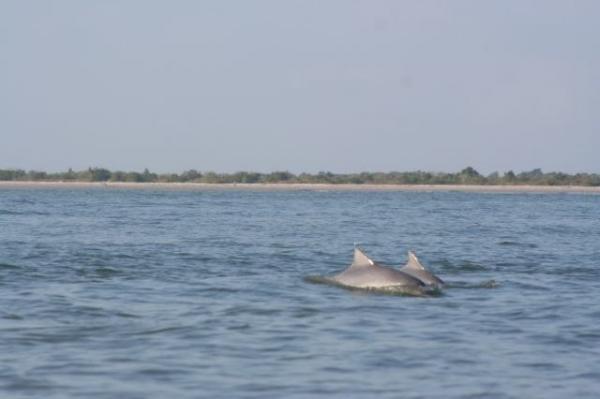
In fact, the story of the Atlantic Forest does not end at the tide line. Its influence extends well out into the coastal waters of Brazil, as the nutrients from the forest flow into the estuaries and bays to form rich feeding grounds for a wide variety of marine creatures.
Among my favorites is the Guianan dolphin, recently split off as a separate species from the estuarine dolphin that swims way up into the fresh waters of the Amazon. These coastal dolphins are shier than their bottle-nosed show-off cousins, but on any boat trip across the Cananeia estuary, near the southern border of São Paulo state, you will see them surfacing constantly.
This group of dolphins is classed as "data deficient" in other words, not enough is known about them to judge if they are threatened or not. I witnessed some fascinating research in this estuary observing a small group of female dolphins that use a unique system of "beach hunting" where they trick fish into retreating to shallow water, then charge them right up to the beach with a big whoosh. The researcher, Marcos Santos, has found that only a few females in the colony use this method and they pass it on to their daughters, an apparent example of cultural, or learned rather than evolved, behavior. Trouble is, this brings them close to busy tourist beaches in the summer and some people think it's fun to chase dolphins on jetskis. Some mothers have aborted their calves, and Santos is trying to get the most sensitive areas declared off-limits.
Deforestation
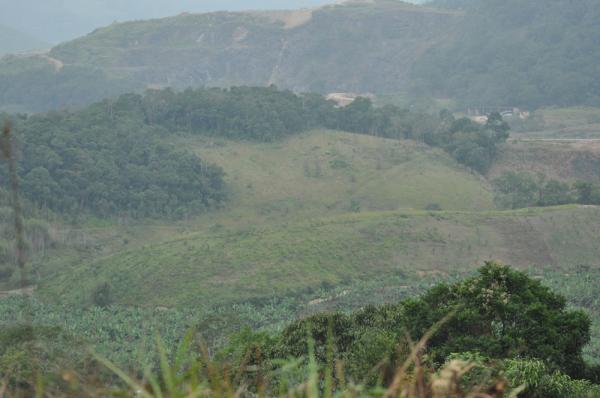
This image from the Ribeira Valley, São Paulo state, illustrates well the condition of much of what remains of the Atlantic Forest. It is very common to see this kind of landscape: small patches of deep green amongst various forms of alternative land occupation. Here you can see cattle pasture, banana plantations and stone quarrying.
The statistics bear this out. If you add up all these smaller remnants (some 250,000 separate fragments have been identified in satellite images) the total amount of forest left adds up to some 13 percent of the original forest extent. However, nearly half of all the remaining area is less than 330 feet (100 m) from the forest edge, and three quarters is less than 820 feet (250 m) from the edge. That makes the majority of the forest very vulnerable to edge impacts such as invasion by weedy plants, fire, livestock damage and hunting. When forest species get trapped in these little islands, they also suffer from in-breeding and loss of resilience against disease and other pressures.
Nevertheless, even the small patches can be valuable for their role as ecological corridors linking up the bigger remnants of forest across the landscape. Some impressive projects are under way to give incentives to landowners to restore forest on part of their land, and help connect the patchy mosaic that is the Atlantic Forest.


